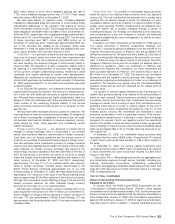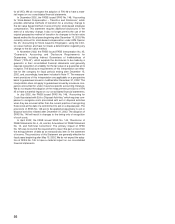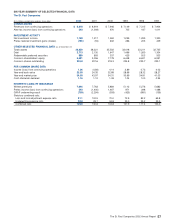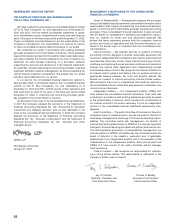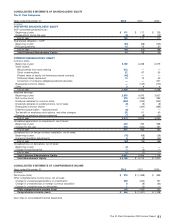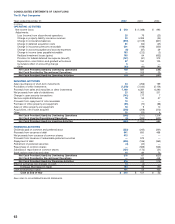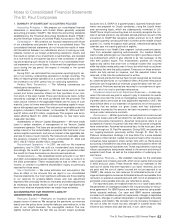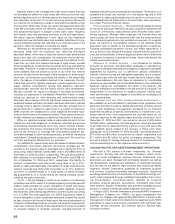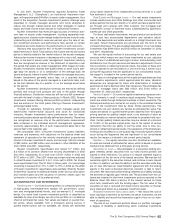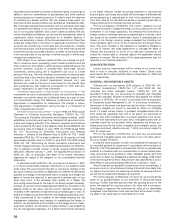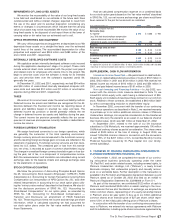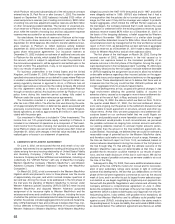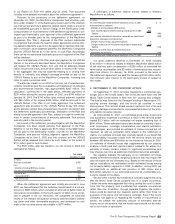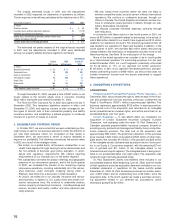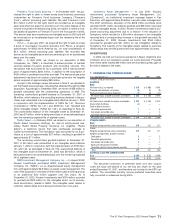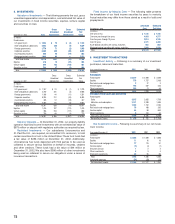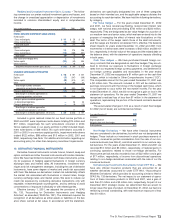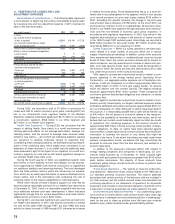Travelers 2002 Annual Report Download - page 67
Download and view the complete annual report
Please find page 67 of the 2002 Travelers annual report below. You can navigate through the pages in the report by either clicking on the pages listed below, or by using the keyword search tool below to find specific information within the annual report.
In July 2001, Nuveen Investments acquired Symphony Asset
Management, LLC (“Symphony”), an institutional investment man-
ager, with approximately $4 billion in assets under management. As a
result of the acquisition, Nuveen Investments’ product offerings were
expanded to include managed accounts and funds designed to
reduce risk through market-neutral and other strategies in several
equity and fixed-income asset classes for institutional investors.
Nuveen Investments has three principal sources of revenue: advi-
sory fees on assets under management, including separately man-
aged accounts, closed-end exchange-traded funds and mutual funds;
underwriting and distribution revenues earned upon the sale of cer-
tain investment products; and performance fees earned on certain
institutional accounts based on the performance of such accounts.
Advisory fees accounted for 90% of Nuveen Investments’ consoli-
dated revenues in 2002.Total advisory fee income earned during any
period is directly related to the market value of the assets managed.
Advisory fee income increases or decreases with a rise or fall, respec-
tively, in the level of assets under management. Investment advisory
fees are recognized as revenue in the statement of operations over
the period that assets are under management. With respect to funds,
Nuveen Investments receives fees based either on each fund’s aver-
age daily net assets or on a combination of the average daily net
assets and gross interest income.With respect to managed accounts,
Nuveen Investments generally earns fees, on a quarterly basis,
based on the value of the assets managed on a particular date, such
as the last calendar day of a quarter, or on the average asset value
for the period.
Nuveen Investments’ distribution revenues are earned as defined
portfolio and mutual fund products are sold to the public through
financial advisors. Distribution revenues will rise and fall commensu-
rate with the level of sales of these products. In March 2002, Nuveen
Investments ceased offering defined portfolio products. Underwriting
fees are earned on the initial public offering of Nuveen Investments’
exchange-traded funds.
Through its subsidiary, Symphony, which manages equity and
fixed-income market-neutral accounts and funds for institutional
investors, Nuveen Investments earns performance fees for invest-
ment performance above specifically defined benchmarks.These fees
are recognized as revenue only at the performance measurement
date contained in the individual account management agreement.
Currently, approximately 80% of such measurement dates fall in the
second half of the calendar year.
We consolidate 100% of Nuveen Investments’ assets, liabilities,
revenues and expenses, with reductions on the balance sheet and
statement of operations for the minority shareholders’ proportionate
interest in Nuveen Investments’ equity and earnings. Minority interest
of $80 million and $93 million was recorded in other liabilities at the
end of 2002 and 2001, respectively.
Nuveen Investments repurchased and retired 5.7 million and
8.2 million of its common shares from minority shareholders in 2002
and 2001, respectively, for a total cost of $151 million in 2002 and
$172 million in 2001. (The 2001 share repurchase total was adjusted
to reflect Nuveen Investments’ 2-for-1 stock split in 2002). No shares
were repurchased from The St. Paul in those years. Our percentage
ownership increased from 77% in 2001 to 79% in 2002 as the effect
of Nuveen Investments’ repurchases were partially offset by Nuveen
Investments’ issuance of additional shares under various stock option
and incentive plans and the issuance of common shares upon the
conversion of a portion of its preferred stock.
ACCOUNTING FOR OUR INVESTMENTS
Fixed Income — Our fixed income portfolio is composed primarily
of high-quality, intermediate-term taxable U.S. government, corpo-
rate and mortgage-backed bonds, and tax-exempt U.S. municipal
bonds. Our entire fixed income investment portfolio is classified as
available-for-sale. Accordingly, we carry that portfolio on our balance
sheet at estimated fair value. Fair values are based on quoted mar-
ket prices, where available, from a third-party pricing service. If
quoted market prices are not available, fair values are estimated
using values obtained from independent pricing services or a cash
flow estimate is used.
Real Estate and Mortgage Loans — Our real estate investments
include warehouses and office buildings and other commercial land
and properties that we own directly or in which we have a partial inter-
est through joint ventures with other investors. Our mortgage loan
investments consist of fixed-rate loans collateralized by apartment,
warehouse and office properties.
For direct real estate investments, we carry land at cost and build-
ings at cost less accumulated depreciation and valuation adjust-
ments. We depreciate real estate assets on a straight-line basis over
40 years. Tenant improvements are amortized over the term of the
corresponding lease.The accumulated depreciation of our real estate
investments was $169 million and $153 million at December 31, 2002
and 2001, respectively.
We use the equity method of accounting for our real estate joint
ventures, which means we carry these investments at cost, adjusted
for our share of undistributed earnings or losses, and reduced by cash
distributions from the joint ventures and valuation adjustments.Due to
time constraints in obtaining financial results, the results of these joint
venture operations are recorded on a one-month lag. If events occur
during the lag period that are significant to our consolidated results,
the impact is included in the current period results.
We carry our mortgage loans at the unpaid principal balances less
any valuation adjustments, which approximates fair value. Valuation
allowances are recognized for loans with deterioration in collateral
performance that is deemed other than temporary. The estimated fair
value of mortgage loans was $82 million and $134 million at
December 31, 2002 and 2001, respectively.
Venture Capital — Our venture capital investments represent own-
ership interests in small- to medium-sized companies. These invest-
ments are made through limited partnerships or direct ownership.The
limited partnerships are carried at our equity in the estimated market
value of the investments held by these limited partnerships. The
investments we own directly are carried at estimated fair value. Fair
values are based on quoted market prices obtained from third-party
pricing services for publicly traded stock, or an estimate of value as
determined by an internal valuation committee for privately-held secu-
rities. Certain publicly traded securities may be carried at a discount
of 10-35% of the quoted market price, due to the impact of various
restrictions that limit our ability to sell the stock. Due to time con-
straints in obtaining financial results, the operations of the limited part-
nerships are recorded on a one-quarter lag. If security-specific events
occur during the lag-period that are significant to our consolidated
results, the impact is included in the current period results.
Equities — Our equity securities are also classified as available-
for-sale and carried at estimated fair value, which is based on quoted
market prices obtained from a third-party pricing service.
Securities on Loan — We participate in a securities lending pro-
gram whereby certain securities from our fixed income portfolio are
loaned to other institutions. Our policy is to require collateral equal to
102 percent of the fair value of the loaned securities. We maintain full
ownership rights to the securities loaned, and continue to earn interest
on them. In addition, we have the ability to sell the securities while they
are on loan. We have an indemnification agreement with the lending
agents in the event a borrower becomes insolvent or fails to return
securities. We record securities lending collateral as a liability and pay
the borrower an agreed upon interest rate.The proceeds from the col-
lateral are invested in short-term investments and are reported on the
balance sheet. We share a portion of the interest earned on these
short-term investments with the lending agent. The fair value of the
securities on loan is removed from fixed income securities on the bal-
ance sheet and shown as a separate investment asset.
Realized Investment Gains and Losses — We record the cost of
each individual investment so that when we sell an investment, we are
able to identify and record that transaction’s gain or loss on our state-
ment of operations.
The size of our investment portfolio allows our portfolio managers
a degree of flexibility in determining which individual investments
The St. Paul Companies 2002 Annual Report 65


